During my frequent rambles through Fern Forest, I’ve run across a number of saurians, both native and non-native. Often they flee at my approach, not trusting the enormous disparity in our sizes to keep them safe. Apparently evolution has favored the flee-from-all-comers approach over the size-em-up approach. Today’s walk, though, was pretty special. It got me to thinking about the dino, in addition to the saur…Before I get to why today’s walk was special, let me introduce you to the lizards I see most often on the site. It won’t take long; there are only four of them.
Among my favorite lizards is our native Green Anole (Anolis carolinensis). These little guys hang around on tree trunks, boardwalk posts, and other vertical surfaces, just flashing their dewlaps when the mood strikes them:
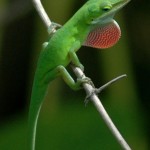
They aren’t always green, though: like all anoles, their color changes from brown to gray to green, depending on their background and other factors. In fact, the “real” common name of this species is Carolina Anole, regardless of the fact that they’re most commonly called the Green Anole. No wonder we need scientific names!
Whatever we choose to call them, though, these charming little guys are declining in our area, perhaps as a result of habitat loss, perhaps under competitive pressure from one of their cousins, only recently introduced here. In any event, I rarely see them unless I’m in a natural area.
The Brown Anole (Anolis sagrei) is the aforementioned bad relation who may or may not be responsible for the decline in numbers of the Green–er, Carolina–Anole. Native to the Bahamas, the Brown Anole was introduced here in south Florida in the 1940s, and is quickly taking over. Like his cousin, he enjoys showing off his dewlap and performing hundreds of pushups (one recent report indicates that it’s a morning and evening affair as well), and clings to any surface imaginable. This is just about the only lizard I see around my house, with the exception of the occasional gecko, and the even more occasional glass lizard (only seen once).

An even more recent introduction, the Brown Basilisk (Basiliscus vittatus), really starts one thinking about the true limitations of the plantigrade stance (for more on this, see Gary Kaiser’s recently published The Inner Bird, in which the author presents the limitations of the birds as dinosaurs theory). These little guys do just fine on their two hind legs, at least for a little while (An anatomist would disagree, sniffing that these two-legged excursions are really just controlled falls; walking on two legs does NOT a biped make. Unfortunately, the anatomists are right: the bipedalism of these creatures is simply too short-lived for me to have taken a successful picture). They can also “walk on water”: they run so fast on their hind legs that they can cross a small stream without swimming. But I do enjoy the crazy cooling fan on top of this guy’s head:
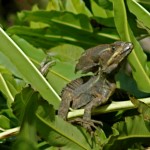
These crests might serve as cooling fans; the fact that they are found almost exclusively on tropical species lends credence to this hypothesis. Many dinosaur body plans appear to have made use of these large surface area dorsal extensions for body cooling as well. Another theory, one that has contemporary and logical evidence, is that these crests are used for display purposes (like the dewlaps on the anoles). Nevertheless, I like the idea of thermal radiators…
The king of all introduced lizards in south Florida has to be the Green Iguana (whose genus and species name are identical, a trick I’ve always admired: Iguana iguana). I’ve seen them six feet long if they’re an inch; I’ve seen them run across rainy streets, get hit by a car, and keep right on running (although I suspect permanent disability and imminent death in the case of that guy); I’ve seen them lounging in treetops, basking by poolsides, and, today, I saw one about five feet away from me on the Wetlands Wander. This guy, while not confrontational, also had no interest in ceding me the right of way. He moved aside a little bit, but he absolutely refused to flee.
I had long suspected that these beasts preyed upon our threatened Burrowing Owl eggs and owlets, but a recent article in the Florida Field Naturalist showed that in fact, the reverse is true: the owls are at least occasional predators of iguanas! Although there is A LOT of speculation that they do indeed pose a threat to our native wildlife, to my knowledge, there is no documented case of an iguana eating a Burrowing Owl egg or nestling, or the egg or nestling of any other bird species. Don’t get me wrong: I’m not arguing in favor of the iguana; I think of it as a pest. I simply don’t believe in scapegoating or unfounded accusations. The city of Boca Raton’s resolution against the species actually gets the facts right, or at least doesn’t outrun science: rather than call it predation, the threat is correctly described as the potential to overtake owl burrows.
And today’s encounter reinforced the scientific wisdom that these creatures are indeed vegetarian. As I watched in awe, this ancient-looking beast browsed a fairly large patch of Spanish Needles (Bidens alba), without even bothering to scatter at my approach, as most of the local lizards do.
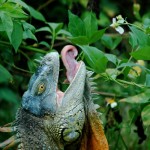
This guy was probably the largest iguana I’ve ever been around, and the cockiest. He absolutely knew that I wasn’t going to do anything to him, and he was going to stand there and keep eating his lunch no matter what. And you know what? He was right: there was simply no way I was interested in messing with this lizard, vegetarian or no… With those sharp teeth, those various spiky projections on his neck, and the strange armored dots, it’s hard not to think of these giant lizards as dinosaurs, even though they’re not.
If you’re interested in reading more about our native lizards native and non-native alike, try Tom Spinker’s southalley site.

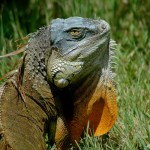
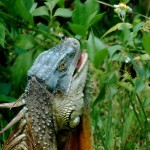
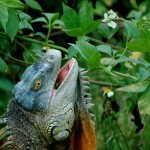
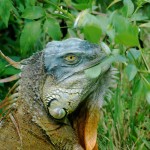

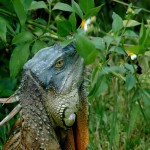

the brown basilisk….is that something we might see here in Vero? My daughter described a lizard that sounded alot like your picture, but though she tried to get a photo with her cell it was too quick!
Absolutely. All over south Florida, and I’m pretty sure can be found up the coast as far as Melbourne/Cape Canaveral. North of that, probably not (but I’m guessing, there…).